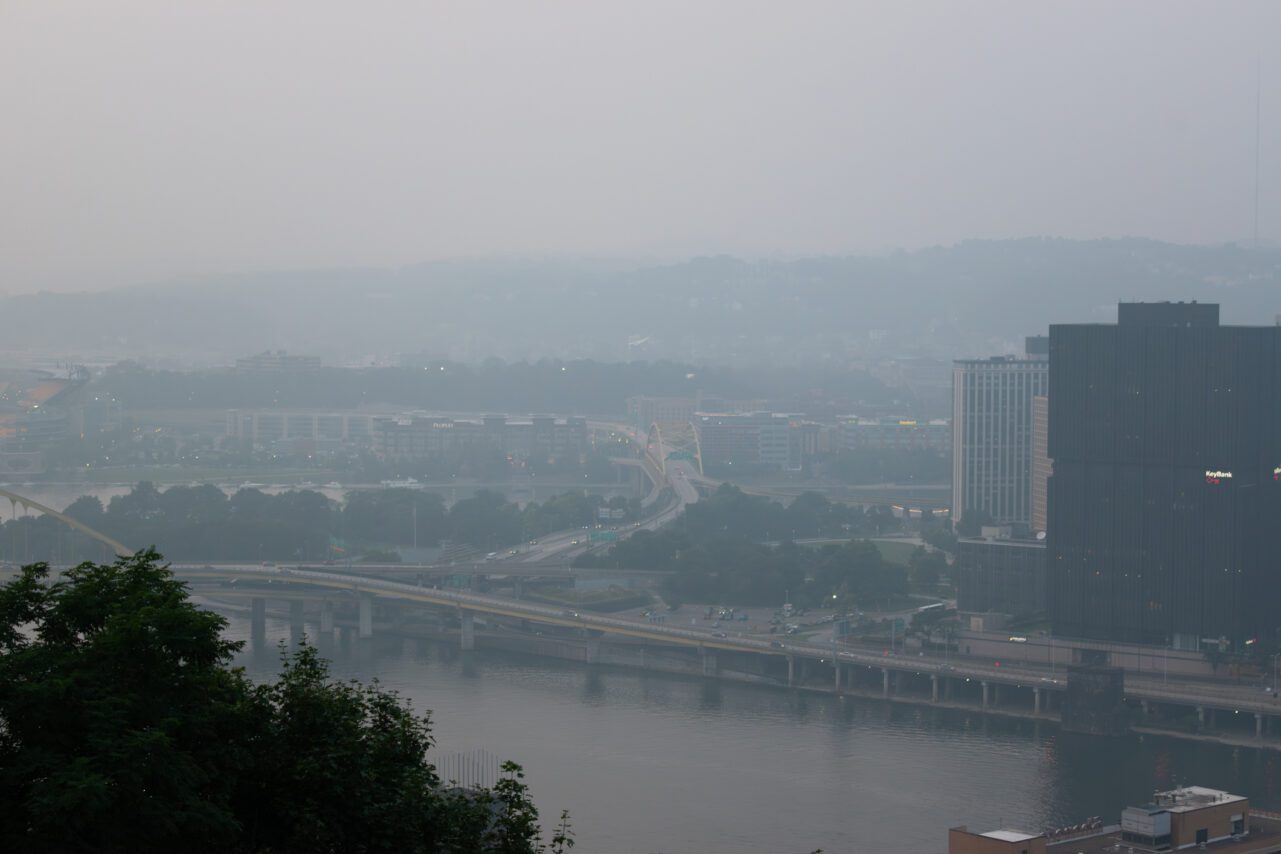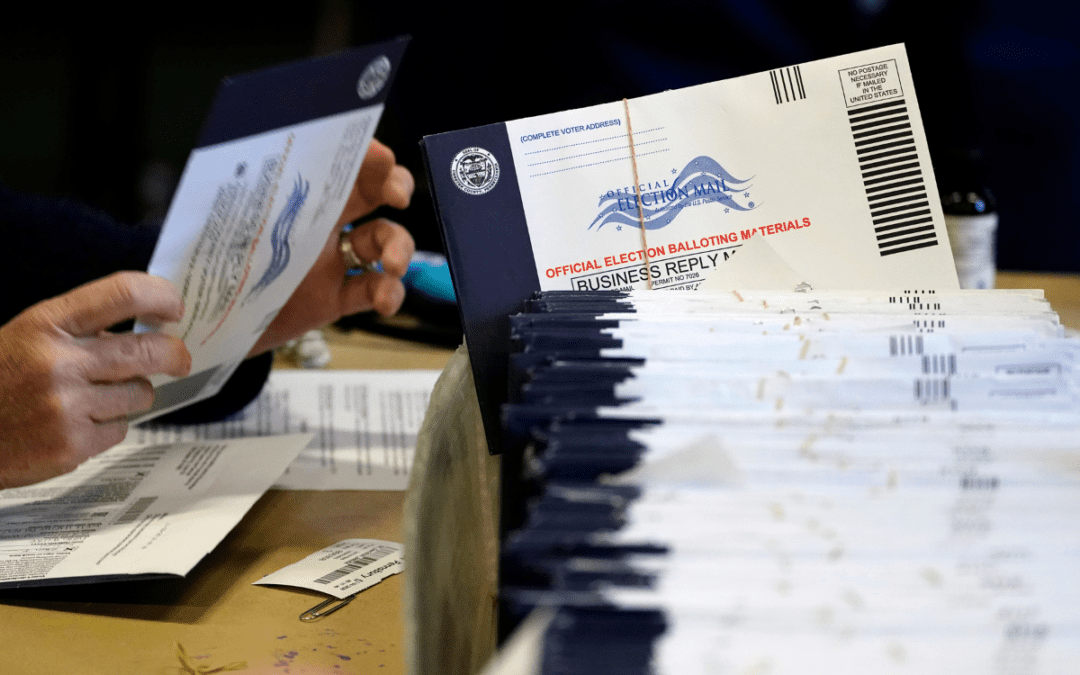
View of downtown district with poor air quality and haze caused by Canadian wildfire smoke, Pittsburgh, PA (Getty images)
According to a recent air quality report from the American Lung Association, ongoing air pollution remains an issue throughout the state.
It seems the air we breathe in Pennsylvania has room for improvement, according to a recent report from the American Lung Association.
The association released its annual “State of the Air” report for 2024, which provides a look at the nation’s, and Pennsylvania’s, air quality, and its impacts on our health. The report grades exposure to unhealthy levels of ozone air pollution, annual particle pollution, and short-term spikes in particle pollution over a three-year period. This year’s report is updated to reflect the new annual particle pollution standard that the US Environmental Protection Agency (EPA) finalized in February.
Currently, 39% of Americans live in areas with failing grades for healthy air, which is an increase of nearly 12 million people over last year, according to the report.
This year’s report also found that individuals in the US experienced more days of particle pollution reaching “very unhealthy” and “hazardous” levels than at any other time since the American Lung Association began tracking such data. Both ozone and particle pollution can lead to serious health problems such as asthma attacks, heart attacks, strokes, preterm births, and impaired cognitive functioning later in life, along with premature death. Particle pollution can also cause lung cancer.
“Climate change is making air pollution more likely to form and more difficult to clean up, so there are actions we can and must take to improve air quality in Pennsylvania, including adopting zero-emission standards for passenger vehicles and heavy-duty trucks,” said Aimee VanCleave, director of advocacy for the American Lung Association. “We are also calling on the EPA to set long-overdue stronger national limits on ozone pollution.”
On a local level, the report had some interesting results for many areas throughout the state.
Allentown-Bethlehem-Easton
Despite slight improvements from last year, the Allentown-Bethlehem-Easton metro area, which covers Carbon, Lehigh, and Northampton counties, was the fourth most polluted area in the Mid-Atlantic region.
The area also ranked 79th worst in the nation for ozone pollution and short-term particle pollution.
For the year-round average level of particle pollution, the metro area ranked 84th worst in the nation. This was better than the area’s ranking in last year’s report of 79th worst in the nation.
Philadelphia-Reading-Camden, NJ
The Philadelphia-Reading-Camden, NJ, metro area improved for all three pollutant measures in this year’s report, including setting new record best-ever values for ozone smog and year-round particle pollution.
Despite these improvements, though, the area still earned a failing grade and is now ranked the worst in the Mid-Atlantic region for ozone smog.
Harrisburg-York-Lebanon
The Harrisburg-York-Lebanon metro area ranked 37th most polluted region in the US for year-round particle pollution and second worst in the Mid-Atlantic region. The area also ranked third worst for daily particle pollution and earned a B grade for ozone.
“Fine particle pollution continues to be a problem in both the Harrisburg, York and Lebanon metro area and the Lancaster metro area — we know that they’re both getting F grades for the year-round measure under the new, more protective year-round standard, and Harrisburg is the second worst after Pittsburgh,” said Kevin Stewart, director of environmental health, American Lung Association.
Pittsburgh-New Castle, OH-Weirton, WV
The Pittsburgh-New Castle, OH-Weirton, WV metro area was the worst in the Mid-Atlantic for both measures of particle pollution, earning failing grades for both; and the third worst in the region for ozone smog with a D grade.
According to Stewart, there are a number of reasons why the air quality is poor in the metro area.
“It is coming from incomplete burning, it can be trash and leaves, it can be from diesel engines, it can be from power plants; the idea is that there’s some kind of combustion going on that is a major part of it, but it’s not the only part. There are other things that go into the air… even ammonia can actually react to form some particles in the air as well,” Stewart said.
Cleanest counties
It wasn’t all bad news for Pennsylvania’s air. More than a dozen counties had no monitored ozone air pollution in unhealthy ranges, making the list of cleanest counties in the state. Those counties include:
- Bradford
- Centre
- Chester
- Clearfield
- Erie
- Fayette
- Franklin
- Lackawanna
- Lehigh
- Luzerne
- Lycoming
- Monroe
- Somerset
- Tioga
- Washington
- Westmoreland
- York
Politics

Breaking down IVF: What it is and why it’s important in the fight for reproductive rights
In vitro fertilization, or IVF, has been at the forefront of a major reproductive rights battle, but what exactly is it? For many Americans, in...

Fetterman introduces bill to protect affordable internet access for 23 million households
The Affordable Connectivity Program expired on Tuesday due to Republican opposition, putting affordable high-speed internet access at risk for 23...

Democrats advance election bill in Pennsylvania long sought by counties to process ballots faster
HARRISBURG, Pa. (AP) — Pennsylvania's House of Representatives on Wednesday approved a bill long sought by counties seeking help to manage huge...
Local News

Look out, Sheetz, Wawa is officially moving into your territory with Central Pa. expansion
The Delaware County-based convenience store chain broke ground on its first Dauphin County location Wednesday in Middletown, with five more stores...

What do you know about Wawa? 7 fun facts about Pennsylvania’s beloved convenience store
Wawa has 60 years of Pennsylvania roots, and today the commonwealth’s largest private company has more than 1,000 locations along the east coast....



